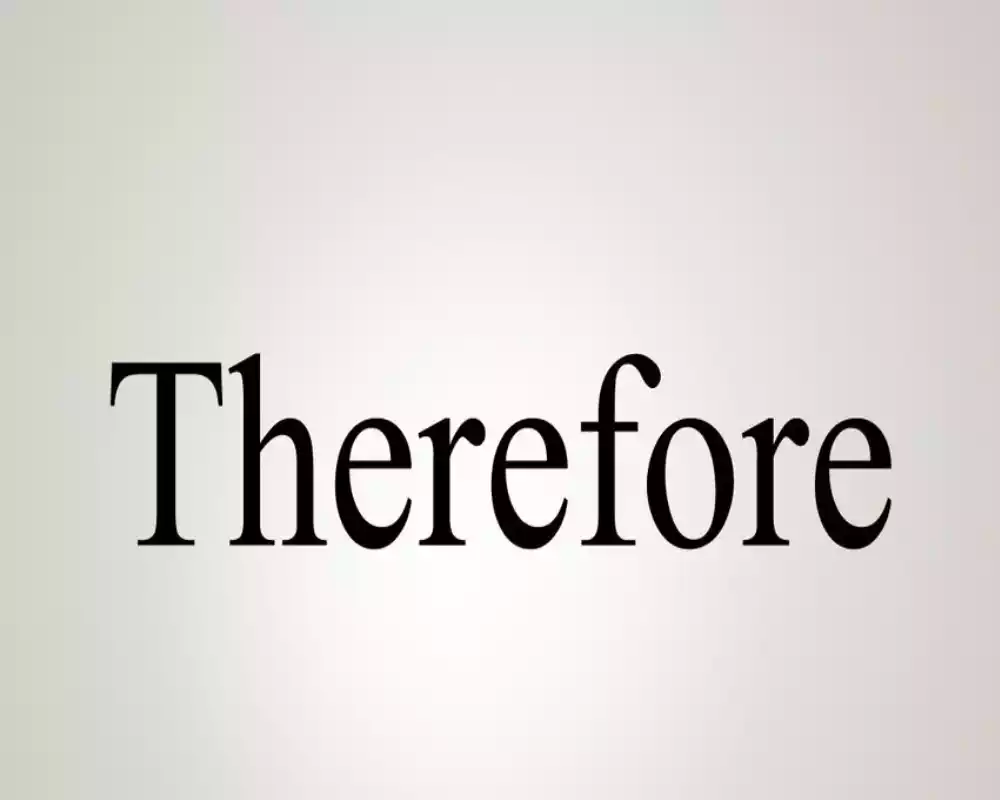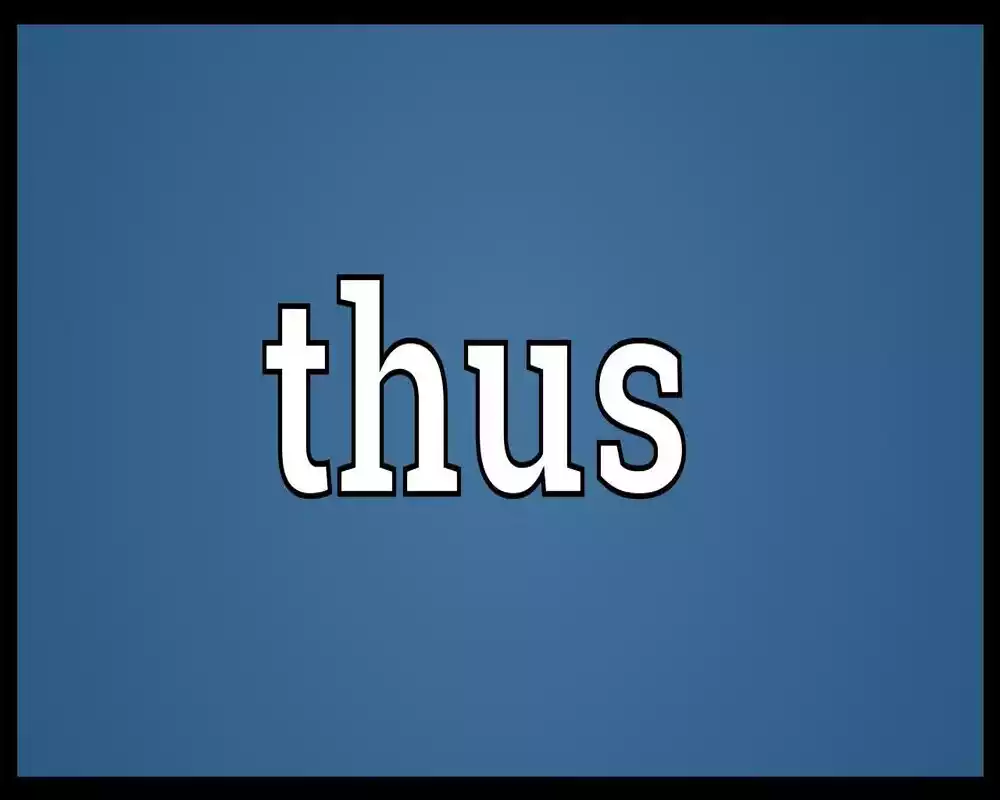Introduction to Therefore and Thus
Certain words in English have different definitions and usages that can impede our communication’s clarity and precision, such as “therefore” (or “thus”) and “thus.” Being aware of their subtle distinctions will enable us to better express our ideas more effectively; this content outline provides you with information regarding both words.
As per its definition, “therefore” refers to any logical conclusion or consequence based on statements and evidence presented; used to establish cause-effect relationships or draw logical inferences from previous actions taken; “thus” represents results or implications from actions undertaken before; suggests sequence or sense in actions undertaken subsequently;
As part of effective communication, understanding the distinctions among “therefore”, “thus”, and “thus” is critical. By finding an apt word in each situation you will better convey meaning accurately and conveyed through speech. We will explore their similarities as well as grammatical usages and meaning.
Definition of Therefore
Therefore is used to signify a logical conclusion or consequence from statements, evidence, and reasoning presented. It shows how an outcome or inference is derived logically from the information given. Emphasizes logic between ideas by emphasizing reasoning and evidence leading up to specific conclusions; frequently seen in formal writing such as academic essays, research papers technical documentations formal discourse where precision and coherence of logic are vitally important.
Definition of Thus
“Thus” adverb is used to explain or emphasize what happens as a consequence of previous statements or actions, usually using legalese. It indicates logical progression by emphasizing consequences as described prior, used for summarization information or giving examples or drawing a conclusion. While its usage varies with context (legal texts versus historical speeches for instance). Thus adds formality and elegance and often associated with archaic styles of writing.
Importance of understanding the difference between Therefore and Thus
Understanding the distinction between “thus” and “therefore” is critical for accurate communication and expression of ideas. Here are a few reasons this distinction matters:
- Clarity and Precision: Using the appropriate word ensures clarity in conveying your intended meaning. “Therefore” and “thus” have distinct connotations and implications and using the wrong word can lead to confusion or misinterpretation. Understanding their nuances helps you choose the word that precisely captures your intended message.
- Logical Coherence: Both “therefore” and “thus” play a crucial role in establishing logical connections between ideas. They convey different types of logical relationships. “Therefore” signifies a cause-and-effect relationship or a logical consequence, while “thus” indicates a result or outcome. By using the correct word, you ensure that your arguments or explanations maintain logical coherence and are more persuasive.
- Academic and Formal Writing: In academic and formal writing, the appropriate usage of language is highly valued. “Therefore” is commonly employed in academic papers, research articles, and technical writing to demonstrate logical reasoning and draw conclusions. “Thus” is often found in formal or literary contexts such as legal documents, historical texts, speeches or poetry. Understanding when and how to use each word enhances the sophistication and professionalism of your writing.
- Contextual Appropriateness: Language usage should be contextually appropriate. Different situations call for different linguistic choices. By grasping the distinction between “therefore” and “thus,” you can tailor your language to fit the tone, formality and style of the specific context. This ability to adapt your language demonstrates linguistic competence and facilitates effective communication with diverse audiences.
- Enhanced Writing Skills: Developing a strong grasp of language nuances, such as the difference between “therefore” and “thus,” improves your overall writing skills. It allows you to select words more consciously and precisely, resulting in clearer and more compelling written communication. Your ability to convey ideas accurately and effectively will be significantly enhanced.
Learning the differences among “therefore”, “thus” will enable you to communicate clearly, precisely and coherently. These terms allow you to demonstrate logical connections while adhering to language conventions. They permit adaptation for various contexts allowing greater impact in written expressions and improving your communication abilities overall.
What does Therefore mean?

“Therefore” is an adverb that signifies a logical consequence or conclusion based on previous statements, evidence or reasoning. It indicates that a particular result or inference follows logically from the information presented.
“Therefore” is used in sentences to demonstrate a relationship between cause and effect or make an logical or deductive inference. It highlights the reasoning or evidence that leads to a specific conclusion. “Therefore” is commonly used in academic writing, logical arguments, research papers, technical documents and formal discourse where precision and logical coherence are crucial.
By using “therefore,” you are indicating that the information or evidence provided earlier logically leads to the stated conclusion. It helps to strengthen the logical flow of your reasoning and emphasizes the connection between ideas.
“Therefore” expresses a logical consequence or conclusion based on preceding information, evidence or reasoning. It signifies a cause-and-effect relationship or a deductive inference and it is commonly used in academic, logical or formal writing to establish logical coherence and draw conclusions.
What does Thus mean?

“Thus” is an adverb that signifies a result, conclusion or action that follows as a consequence of something previously mentioned or described. It indicates that something is happening or being done in a particular manner or fashion as a direct outcome of the preceding information or circumstances. “Thus” emphasizes the cause-and-effect relationship or the logical sequence of events.
When used in a sentence, “thus” often introduces a complete statement or serves as a transitional word within a sentence. It helps summarize information, present a conclusion or provide an example. The word “thus” can add a sense of formality, elegance or literary flair to the language and it is commonly found in formal writing or in contexts such as legal documents, historical texts, speeches or poetry.
“Thus” indicates a result or action that follows logically or as a consequence of what has been previously mentioned or described. It emphasizes the cause-and-effect relationship and can be used to provide a conclusion, summarize information or present an example in a formal or literary context.
Difference Between Therefore and Thus
The difference between “therefore” and “thus” lies in their connotations, usage and the specific logical connections they convey. Here is a breakdown of the distinctions:
Connotation and Tone:
- Therefore: “Therefore” has a formal and objective connotation. It is commonly used in academic or professional settings, emphasizing logical reasoning and rationality.
- Thus: “Thus” carries a formal or even archaic connotation. It can be seen as more literary or poetic, adding elegance or sophistication to the language.
Logical Connection:
- Therefore: “Therefore” indicates a logical consequence or conclusion drawn from previous statements or evidence. It emphasizes cause-and-effect relationships, implying that the conclusion logically follows from the information presented.
- Thus: “Thus” indicates a result or outcome derived from a preceding action, statement or set of circumstances. It emphasizes the consequence or the logical sequence of events that leads to the stated result.
Sentence Structure:
- Therefore: “Therefore” is often used to connect two independent clauses or introduce a dependent clause within a sentence. It highlights the relationship and logical connection between ideas.
- Thus: “Thus” typically introduces a complete sentence or functions as a transitional word within a sentence. It helps indicate a conclusive statement, summarize preceding information or present an example.
Usage in Academic or Formal Writing:
- Therefore: “Therefore” is commonly used in academic and formal writing, especially in logical arguments, research papers and technical documents. Its precise usage helps present conclusions or draw inferences based on logical reasoning.
- Thus: “Thus” is frequently found in formal or literary contexts, such as legal or historical texts, speeches or poetry. It adds a touch of formality and is often used to summarize information, provide a conclusive statement or present an example.
Understanding the nuanced differences between “therefore” and “thus” enables you to select the appropriate word for conveying logical connections and maintaining clarity and precision in your communication. It allows you to adapt your language to the context, tone and desired impact, whether it’s in academic writing, professional discourse or formal settings.
Effective Strategies for Using “Therefore” and “Thus” in Writing
Using “therefore” and “thus” effectively in writing involves considering the context, clarity and logical coherence of your statements. Here are some strategies to help you use these words proficiently:
- Understand the Context: Consider the tone and formality of your writing. “Therefore” is commonly used in academic and formal writing, while “thus” is often found in formal or literary contexts. Ensure that your choice aligns with the desired style and tone of your piece.
- Establish Clear Logical Connections: Use “therefore” to denote a logical consequence or conclusion based on previous statements or evidence. It highlights the cause-and-effect relationship. Use “thus” to indicate a result or outcome derived from a preceding action or circumstance. It emphasizes the consequence or the logical sequence of events.
- Use Sentence Structure Effectively: “Therefore” is often used to connect two independent clauses or introduce a dependent clause. It establishes a clear connection between ideas. “Thus” is typically used to introduce a complete sentence or as a transitional word within a sentence. Ensure that the sentence structure supports the intended meaning and logical flow of your writing.
- Maintain Clarity and Precision: Both “therefore” and “thus” contribute to clarity and precision in your writing. Be mindful of the cause-and-effect relationship or the logical sequence you are conveying. Avoid using the words ambiguously or interchangeably, as it may lead to confusion or weaken the logical coherence of your arguments.
- Consider Sentence Placement: Determine the most effective placement of “therefore” or “thus” in your sentences. Placing them at the beginning or near the beginning of a sentence can help signal the logical connection or conclusion. They can also be placed within a sentence to emphasize a particular point or to provide a concise summary.
- Proofread and Revise: After writing, review your use of “therefore” and “thus” to ensure they accurately convey your intended meaning and contribute to the logical coherence of your writing. Check for any potential misinterpretations or instances where the words could be replaced with clearer alternatives.
By implementing these strategies, you can effectively use “therefore” and “thus” to strengthen the logical flow, clarity and precision of your writing. Remember to consider the context, maintain logical connections and proofread your work to ensure effective and impactful usage of these words.
Common Mistakes and Pitfalls to Avoid
When using “therefore” and “thus” in writing, It’s important to be aware of common mistakes and pitfalls to avoid.

Here are some of them:
- Incorrect Usage: One common mistake is using “therefore” or “thus” without considering their precise meanings or logical connections. Ensure that you are using the word that accurately reflects the cause-and-effect relationship or logical consequence you intend to convey.
- Overuse: Using “therefore” or “thus” excessively can make your writing sound repetitive or monotonous. Reserve their usage for instances where they add clarity, logical coherence or emphasis. Be concise and precise in your language choices.
- Confusing “Therefore” and “Thus”: While they have similar meanings, “therefore” and “thus” have distinct connotations and grammatical usage. Pay attention to their specific nuances and choose the word that best fits the intended tone, context and logical connection.
- Lack of Clarity: Using “therefore” or “thus” without providing clear supporting statements or evidence can lead to ambiguity. Make sure the preceding information is well-established and logically supports the conclusion or result you present using these words.
- Ignoring Sentence Structure: Consider the grammatical structure of your sentences when using “therefore” or “thus.” Ensure that they are appropriately placed to maintain clarity and logical flow. Avoid awkward sentence constructions that disrupt the readability of your writing.
- Failing to Proofread: Mistakes in grammar, punctuation or word choice can undermine the effectiveness of your usage of “therefore” or “thus.” Always proofread your writing carefully to catch any errors and ensure that these words are used accurately and appropriately.
- Neglecting Context and Audience: Adapt your usage of “therefore” and “thus” to the specific context and intended audience of your writing. Your words will resonate more powerfully with your audience if you use appropriate tones, formalities and styles in how you say them.
By avoiding these common mistakes and pitfalls, you can use “therefore” and “thus” effectively, enhancing the clarity, logical coherence and impact of your writing.
Enhancing Clarity and Readability with “Therefore” and “Thus”
Consider these strategies to enhance clarity and readability in your writing when using “therefore” or “thus”:
- Provide Context: Before using “thus” and “therefore”, make sure that all information or arguments have been clearly articulated. This helps readers understand the logical connection or cause-and-effect relationship between ideas.
- Use Concise Language: Be concise in your writing by using precise and straightforward language. Avoid excessive wordiness or unnecessary repetition. This helps readers grasp your intended meaning without confusion or ambiguity.
- Use Transition Phrases: Pair “therefore” or “thus” with appropriate transition phrases to indicate the logical connection between ideas. For example, “therefore, as a result, consequently, thus in conclusion.” These phrases help guide readers through the thought process and improve the coherence of your writing.
- Keep Your Sentence Structure In Mind: Whenever including “therefore” or “thus”, be conscious of how your sentences are constructed to maintain readability and clarity for readers. Make sure they’re well structured with accurate grammar usage for optimal readability and comprehension. Avoid overly complex or convoluted sentence constructions that may confuse readers.
- Vary Sentence Beginnings: To enhance readability, vary the way you begin sentences that include “therefore” or “thus.” This helps avoid repetitive sentence structures and adds variety to your writing style.
- Use Examples or Illustrations: Support your statements with concrete examples or illustrations that demonstrate the logical connection or consequence you are presenting. This provides readers with a clearer understanding and strengthens your argument or explanation.
- Proofread and Revise: After writing, proofread your work to ensure that your usage of “therefore” and “thus” contributes to clarity and readability. Check for any potential confusion, lack of coherence in grammar or punctuation.
By employing these strategies, you can enhance the clarity and readability of your writing when using “therefore” and “thus.” Consider the context, structure your sentences effectively and provide supporting information to ensure that your ideas flow logically and are easily understood by your readers.
Practical Examples of “Therefore” and “Thus” in Different Contexts
Here are some practical examples of how to use “therefore” and “thus” in different contexts:
Academic Writing:
- This study revealed a strong association between smoking and lung cancer; therefore it serves as an independent risk factor.
- “The experimental results did not support the initial hypothesis. Thus, further investigation is warranted to determine the underlying factors.”
Business Communication:
- “The company experienced a decline in sales over the past quarter; therefore, a new marketing strategy should be implemented to boost revenue.”
- “The cost analysis revealed significant inefficiencies in the manufacturing process; thus, streamlining operations can lead to cost savings.”
Legal Context:
- “The defendant was found guilty of multiple counts of fraud. Therefore, the court imposed a hefty fine and a prison sentence.”
- “The evidence presented clearly establishes the defendant’s motive and opportunity; thus, it strengthens the prosecution’s case.”
Historical Analysis:
- “The economic downturn in the 1930s resulted in widespread unemployment and poverty. Therefore, it paved the way for social and political reforms.”
- “The diplomatic negotiations failed to reach a consensus; thus, tensions escalated, ultimately leading to the outbreak of war.”
Personal Statement:
- “I have a passion for environmental conservation; therefore, I have actively engaged in local sustainability initiatives and pursued a degree in environmental science.”
- “I have dedicated years to mastering the violin; thus, I have performed in numerous prestigious concerts and won several awards.”
These examples demonstrate how “therefore” and “thus” can be used in various contexts, such as academic writing, business communication, legal contexts, historical analysis and personal statements. They showcase the logical connections, conclusions or results derived from the preceding information or circumstances. Remember to adapt the usage based on the specific context, tone and purpose of your writing.
Using “Therefore” and “Thus” in Conversational Writing
While “therefore” and “thus” are more commonly used in formal or academic writing, they can still be incorporated into conversational writing to add clarity and precision to your statements. Here are a few examples of how they can help you write conversational texts:
Explaining a Reason:
- “I missed the train and therefore I won’t be able to make it to the meeting.”
- “I have been working long hours all week thus I am looking forward to a relaxing weekend.”
Presenting a Logical Consequence:
- “The weather forecast predicts heavy rain tonight; therefore, we should bring umbrellas.”
- “I couldn’t locate my keys anywhere so I had to ask for my roommate to let my in.”
Expressing an Intended Outcome:
- “I plan to study diligently for the exam; therefore, I expect to achieve a good grade.”
- “I have been saving money consistently; thus, I will be able to afford the vacation I’ve been dreaming of.”
Making a Recommendation or Offering a Solution:
- “The current system is inefficient and error-prone; therefore, I suggest implementing a new software solution.”
- “We have encountered numerous challenges with the current process; thus, we should consider alternative approaches.”
Drawing a Conclusion or Summarizing Information:
- “The evidence clearly points to the suspect’s guilt; therefore, we can conclude that they committed the crime.”
- We carefully considered all options, their advantages and disadvantages. The best course of action, therefore is to move forward with Plan B.”
When using “therefore” and “thus” in conversational writing, make sure to maintain a natural flow and adjust the level of formality to suit the context. While conversational writing is typically more casual, incorporating these words can still enhance the clarity and logical coherence of your statements.
Conclusion
Particularly “therefore” and “thus,” play a crucial role in effective communication and persuasive writing. By mastering the skill of using these connectors appropriately, writers can enhance the clarity, coherence, and impact of their content. Employing “therefore” and “thus” is not just a stylistic choice but a strategic approach to engage readers and achieve the desired outcomes.



